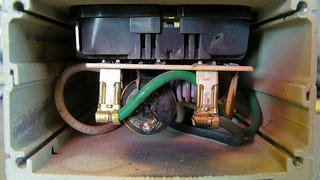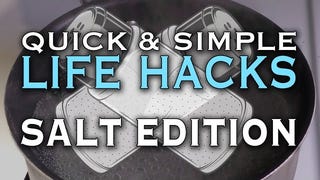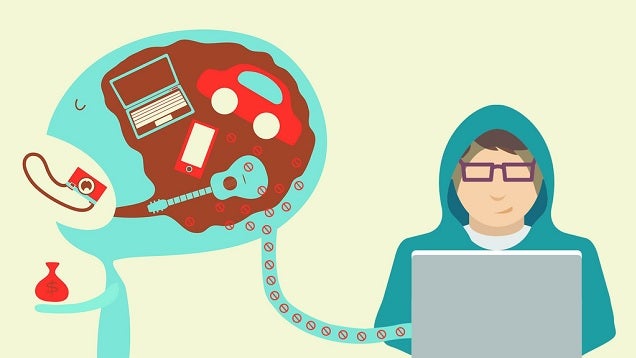
We all buy things from time to time that we don't really need. It's okay to appeal to your wants every once in a while, as long as you're in control. If you struggle with clutter, impulse buys, and buyer's remorse, here's how to put your mind in the right place before you even set foot in a store.
Understand How Your Own Brain Works Against You
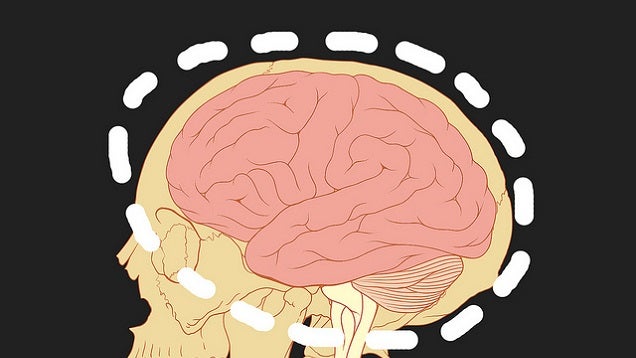
It may come as no surprise to learn that stores employ all kinds of tricks to get you to part ways with your cash, and your brain plays right along. Through psychological tricks, product placement, and even color, stores are designed from the ground up to increase spending. We've talked about the biggest things stores do to manipulate your senses, but here are some of the biggest things to look out for:
- Color: Stores use color to make products attractive and eye-catching, but they also use color on price labels. Red stands out and can encourage taking action, that's why it's commonly associated with sale signage and advertising. When you see red, remember what they're trying to do to your brain with that color. You don't to buy something just because it's on sale.
- Navigation Roadblocks: Stores force you to walk around stuff you don't need to find the stuff you are really after. Have a list of what you need before you go in, go straight to it, and imagine it's the only item in the store.
- The Touch Factor: Stores place items they want to sell in easy to reach locations and encourage you to touch them. Don't do it! As soon as you pick something up, you're more likely to buy it because your mind suddenly takes ownership of the object. Don't pick anything up and don't play with display items.
- Scents and Sounds: You'll probably hear classic, upbeat tunes when you walk into a store. The upbeat music makes you happy and excited, while playing familiar songs makes you feel comfortable. They also use pleasant smells to put your mind at ease. A happy, comfortable mind at ease is a dangerous combination for your brain when shopping. There's not much you can do to avoid this unless you shop online, but it's good to be aware of it.
And sure, we can blame the stores all we want, but you won't change how they operate—you can only be aware of how your brain is falling for their tricks. Even without the stores, your brain is working against you on its own, thanks to some simple cognitive biases.
For example, confirmation bias makes you only believe the information that conforms to your prior beliefs, while you discount everything else. Advertisers appeal to this bias directly by convincing you one item is better than another with imagery and other tricks, regardless of what hard facts might say. Keep your mind open, do your own research, and accept when you're wrong about a product. The Decoy effect is also a commonly used tactic. You think one product is a deal because it's next to a similar product that's priced way higher. Even if it's a product you need, it's probably not as good of a deal as it looks right then and there. Again, always research beforehand and be on the lookout for this common trick to avoid impulse buys.
Make a List of Everything You Own and Do Some Decluttering
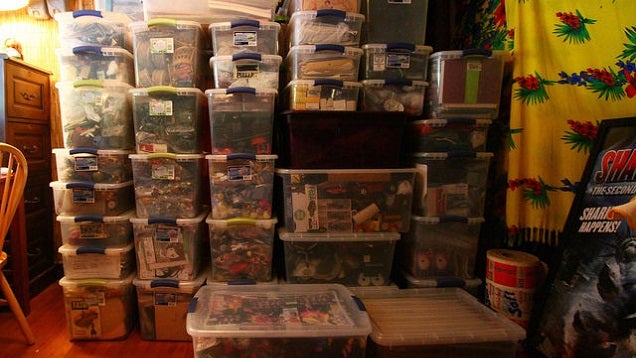
Now that you know what you're up against, it's time to start changing the way you think. Before you can stop buying crap you don't need, you need to identify what that crap is. The first step is to make a list of every single thing you own. Every. Single. Thing. This might sound extreme, but you need to gather your data so you can start reprogramming your mind.
The purpose of this exercise is twofold: you see what you already have and don't need to ever buy again, and you get to see what you shouldn't have bought in the first place. As you list everything out, separate items into categories. It's extremely important that you are as honest with yourself as possible while you do this. It's also important you actually write this all down or type it all out. Here is the first set of categories to separate everything into:
- Need: You absolutely need this item to get by on a day to day basis.
- Sometimes Need: You don't need this item every day, but you use it on a somewhat regular basis.
- Want: You bought this item because you wanted it, not because you needed it.
- Crap: You don't have a good reason why you have it and you already know it needs to go (there's probably a few of these items, at least).
Leave the things you listed as "needs" alone, put your stuff listed as "crap" in a pile or box to go bye-bye, and move your attention back to your "sometimes need" and "want" lists. You need to go back over both of those lists because you probably fudged some of the listings, either subconsciously or intentionally. Now ask yourself these three questions as you go through both the "sometimes need" and "want" lists:
- When was the last time I used this?
- When will I use this again?
- Does this item bring you joy?
Remember to be honest and adjust your lists accordingly. There's nothing wrong with keeping things you wanted. Material items can bring happiness to many people, but make sure the items on your "want" list actively provide you joy and are being used. If an item doesn't get much use or doesn't make you happy, add it to the "crap" list.
Once you have everything organized, it's time to do some serious decluttering. This listing exercise should get you started, but there are a lot of other great ideas when it comes to ditching the junk you don't need. Regardless, everything on your "crap" list needs to go. You can donate it, sell it at a yard sale, give it away to people know, whatever you like. Before you get rid of everything, though, take a picture of all your stuff together. Print out or save the picture somewhere. Some of it was probably gifts, but in general, this is all the crap you bought that you don't need. Take a good look and remember it.
See How Much Money and Time You Spent on the Stuff You Threw Out

Now take a look at your "crap" list again and start calculating how much you spent on all of it. If it was a gift, mark it as $0. Otherwise, figure out the price of the item at the time you bought it. If you got a deal or bought it on sale it's okay to factor that in, but try to be as accurate as possible. Once you have the price for each item, add it all together. Depending on your spending habits this could possibly be in the hundreds to thousands of dollars. Remember the picture you took of all this stuff? Attach the total cost to the picture so you can see both at the same time.
With the money cost figured out, you should take a look at the other costs too. Time is a resource just like any other, and it's a finite one. What kind of time did you pour into these things? Consider the time you spent acquiring and using these items, then write it all down. These can be rough estimations, but go ahead and add it all up when you think you've got it. Now attach the total time to same picture as before and think of the other ways you could have spent all that time. This isn't to make you feel bad about yourself, just to deliver information to your brain in an easy-to-understand form. When you look at it all like this, it can open your eyes a little more, and help you think about purchases in the future. You'll look at an item and ask yourself, "Will this just end up in the picture?"
List Every Non-Material Thing In Your Life that Makes You Happy

Now it's time to make a different list. While material items may bring plenty of joy, the things in your life that make you happiest probably can't be bought. Get a separate piece of paper or create a new document and list out everything in your life that makes you happy. If you can't buy it, it's eligible for the list. It doesn't matter if it only makes you crack a smile or makes you jump for joy, list it out.
These are probably the things that actually make you want to get out of bed in the morning and keep on keepin' on. Once you have it all down, put it in your purse or wallet. The next time you feel the urge to buy something, whip this list out first and remind yourself why you probably don't need it.
Spend Some Time Away from Material Things to Gain Perspective

If you're having a really hard time with your spending, it can help to get away from material objects completely. When you're constantly surrounded by stuff and have access to buying things at all times, it can be really tough to break the habit. Spend a day in the park enjoying the sights and sounds of the outdoors, go camping with some friends, or hike a trail you haven't been on before.
Essentially, you want to show yourself that you don't need your "things" to have a good time. When you realize how much fun you can have without all the trinkets and trivets, you'll start to shut down your desire to buy them. If you can't get really get away right now, just go for a walk without your purse or wallet (but carry your ID). If you can't buy anything, you'll be forced to experience things a different way.
Develop a Personal "Should I Buy This?" Test
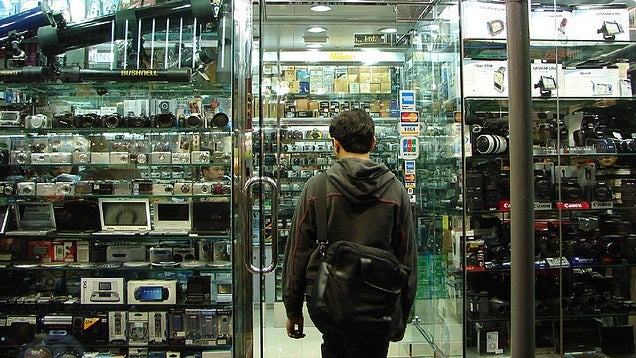
If you don't have a personal "should I buy this?" test, now's the perfect time to make one. When you find an item you think you need or want, it has to pass all of the questions you have on your test before you can buy it. Here's where you can use all of the data you've gathered so far and put it to really good use. The test should be personalized to your own buying habits, but here are some example questions:
- Is this a planned purchase?
- Will it end up in the "crap" list picture one day?
- Where am I going to put it?
- Have I included this in my budget?
- Why do I want/need it?
Custom build your test to hit all of your weaknesses. If you make a lot of impulse buys, include questions that address that. If you experience a lot of buyer's remorse, include a lot of questions that make you think about the use of item after you buy it. If buying the latest and greatest technology is your weakness, Joshua Becker at Becoming Minimalist suggests you ask yourself what problem the piece of tech solves. If you can't think of anything it solves or if you already have something that solves it, you don't need it. Be thorough and build a test that you can run through your mind every time you consider buying something.
Learn to Delay Gratification and Destroy the Urge to Impulse Buy

When it comes to the unnecessary crap we buy, impulse purchases probably make up a good deal of them. We love to feel gratification instantly and impulse buys appeal to that with a rush of excitement with each new purchase. We like to believe that we have control over our impulses all the time, but we really don't, and that's a major problem for the ol' wallet.
The key is teaching your brain that it's okay to wait for gratification. You can do this with a simple time out every time you want something. Look at whatever you're thinking of buying, go through your personal "should I buy this?" test, and then walk away for a little while. Planning your purchases ahead is ideal, so the longer you can hold off, the better. Set yourself a reminder to check on the item a week or month down the line. When you come back to it, you may find that you don't even want it, just the gratification that would come with it. If you're shopping online, you can do the same thing. Walk away from your desk or put your phone in your pocket and do something else for a little while.
You can also avoid online impulse purchases by making it harder to do. Block shopping web sites during time periods you know you're at your weakest, or remove all of your saved credit card or Paypal information. You can also practice the "HALT" method when you're shopping online or in a store. Try not to buy things when you're Hungry, Angry, Lonely, or Tired because you're at your weakest state mentally. Last, but not least, the "stranger test" can help you weed out bad purchases too.
The last thing you should consider when it comes to impulse buys is "artificial replacement." As Trent Hamm at The Simple Dollar explains, artificial replacement can happen when you start to reduce the time you get with your main interests:
Whenever I consistently cut quality time for my main interests out of my life, I start to long for them. As you saw in that "typical" day, I do make room for spending time with my family, but my other two main interests are absent. If that happens too many days in a row, I start to really miss reading. I start to really miss playing thoughtful board games with friends. What happens after that? I start to substitute. When I don't have the opportunity to sit down for an hour or even for half an hour and really get lost in a book, I start looking for an alternative way to fill in the tiny slices of time that I do have. I'll spend money.
You probably have things in your life that provide plenty of gratification, so don't get caught substituting it with impulse buys. Always make sure you keep yourself happy with plenty of time doing the things you like to do and you won't be subconsciously trying to fill that void with useless crap.
Turn the Money You Save Into More Money
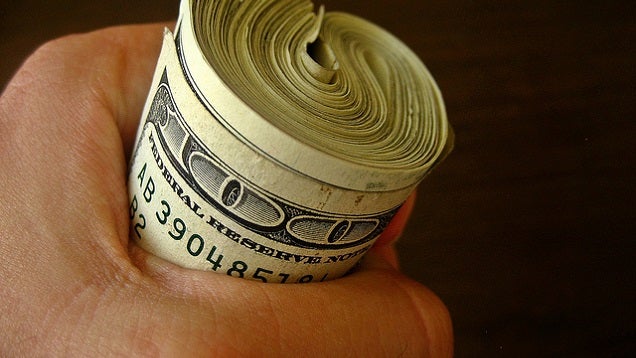
Once you've programmed your mind to stop buying crap you don't need, you'll have some extra cash to play with. Take all that money and start putting it toward your future and things you will need further down the road. You might need a home, a vehicle, or a way to retire, but none of that can happen until you start planning for it.
Start by paying off any debts you already have. Credit cards, student loans, and even car payments can force you to live paycheck to paycheck. Use the snowball method and pay off some small balances to make you feel motivated, then start taking out your debt in full force with the stacking method: stop creating new debt, determine which balances have the highest interest rates, and create a payment schedule to pay them off efficiently.
With your debts whittled down, you should start an emergency fund. No matter how well you plan things, accidents and health emergencies can still happen. An emergency fund is designed to make those kinds of events more manageable. This type of savings account is strictly for when life throws you a curveball, but you can grow one pretty easily with only modest savings.
When you've paid off your debt and prepared yourself for troubled times, you can start saving for the big stuff. All that money you're not spending on crap anymore can be saved, invested, and compounded to let you buy comfort and security. If you don't know where to start, talk to a financial planner. Or create a simple, yet effective "set and forget" investment portfolio. You've worked hard to reprogram your mind, so make sure you reap the benefits for many years to come.
Photos by cmgirl (Shutterstock), Macrovector (Shutterstock), J E Theriot, davidd, George Redgrave, David Amsler, Arup Malakar, J B, jakerome, 401(K) 2012.

